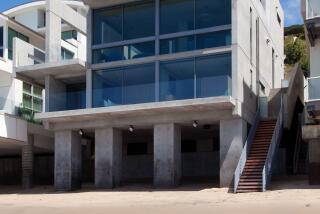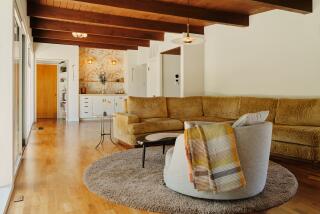Making the Place Sing
Reflecting on the 80-year-old, two-bedroom bungalow that she and her boyfriend nurtured from a “disgusting, crumbling mess of a house” into a polished cottage radiating warmth and appeal, Kerrie White doesn’t see just plaster, wood and glass. She sees herself.
“This is like our child. We brought it to life,” said White, 39, a musician and singer, who helped pull off the whole-house remodel for just $16,300.
The “adventure,” as the couple described it, began late last year, when White and Jesse Loya, 45, also a musician, began looking for a starter house to buy in Los Angeles.
Their agent, Paul Kellogg of Coldwell Banker in Beverly Hills, at first showed them houses that were in move-in condition.
But the couple weren’t necessarily looking for something clean and pristine. They wanted a house that “felt good” to them, no matter what the condition.
“There’s an intangible feeling about a place,” said White, who found that some fixed-up houses had such bad vibes that she “couldn’t even walk in.”
The couple, who have three school-age children between them, also wanted a house for less than $200,000. Although they were pre-qualified for a $325,000 loan, Loya didn’t want to commit to such a large mortgage, which would cramp his and White’s flexible work-parenting lifestyle.
“We could do it,” Loya said, “if we both got ... jobs.” “Real jobs,” White emphasized.
So they asked Kellogg to start showing them houses that were in disrepair. “I don’t care if you think it’s gross,” White told him. “I want something that’s a total dump.”
Kellogg started faxing them listings that might fit the bill. They drove through Silver Lake and Atwater neighborhoods looking for possibilities, even vacant homes that had been boarded up.
“They were in no hurry,” Kellogg said. “They were intent on finding the right house.”
It took six months to locate the bungalow--a new listing in Silver Lake priced at $185,000--and White instantly knew it was the one. She liked what she called “the bones” of the square cottage sitting high off the street, its entrance sheltered by a covered porch and flanked by French doors. Never mind the cracked steps, weed-strewn yard, peeling paint and crumbling siding.
“We want it,” she told the agent, even before she looked inside.
Loya was sold when he walked around the house to the backyard. “There was a big avocado tree with horizontal branches,” he recalled. “The kids [had] said, ‘Find us a house with a big tree.”’
Once they got inside, White focused on the home’s positives: the traditional bungalow floor plan, wooden floors, thick moldings and a built-in dining room cabinet. The crumbling ceilings, walls and plumbing, and the odors left by transients who had sought shelter there, didn’t faze her. Only later would she and Loya discover the rat’s nest inside a wall.
Using a key, White scratched through layers of paint covering the fireplace facade and came upon exquisitely hued antique tiles.
“We were thrilled,” she said. “It had this wonderful energy.”
In Kellogg’s estimation, the purchase was wise. Comparable properties on the street--those with two bedrooms and one bath but fixed up--were selling for more than $300,000, and White had experience with remodeling. Said Kellogg: “She really knew what she was getting into.”
The first step in the four-month remodel was extensive demolition: removing rotted ceilings in all but the living room, taking the plaster off half the walls, gutting the bathroom and kitchen and hauling away piles of junk.
Loya did much of the work but got help from day laborers and friends (referred to by the couple as “musicians with skills”). Each received $10 an hour. At $4,000, the dumpster fees and demolition labor totaled nearly one-quarter of the remodeling cost.
Loya then stripped the wooden floors. Hunched over the task one day, perspiration from his brow dripped onto the floor. “Our sweat is in this house,” White said.
Midway through the remodel, White began to feel the immensity of what she had taken on. The walls looked like someone had taken a shotgun to them; she and Loya argued over various issues, and a robber stole $1,000 worth of tools. “It was beating me down,” she said, but they pressed on.
Cleaning the moldings of layers of old paint required experimentation. At first, Loya tried a chemical paint stripper, but it made a mess. Next, he took a heat gun to them. “Hours and hours and hours with one little piece,” White said. Finally, he decided to skim joint compound over moldings that were left in place to get a smooth surface, and then he painted. Moldings that were taken down were run through a planer.
To replace the walls and ceilings, Loya did much of the work with the help of a day laborer who turned out to be an excellent craftsman.
In outfitting the kitchen and bathroom with appliances and fixtures, Loya and White put their scavenger skills to use scouring their favorite salvage yard, Santa Fe Wrecking Co. in Los Angeles, looking in dumpsters and visiting the sites of building demolitions. They took an old metal sink unit to a friend’s auto body shop for a paint job.
“That’s GM white,” Loya said of the kitchen sink.Despite extensive searching, the couple could not find proper-size wooden windows for the bedroom and kitchen, so Loya made them by hand. A musician friend replaced the plumbing and laid tile in the bathroom.
With the interior of the house nearing completion, the wall and trim colors were major considerations. Loya and White say they are sensitive to subtle differences of shade and tint.
At first, they tried a green wall color made by Ralph Lauren, a favorite brand of White, who once worked in the fashion industry. But it contained too much gray for their taste. In fact, White told Loya, “If you paint the house that color, I’m not going to live here.”
Finally, Loya suggested they use one of his favorite brands, Martha Stewart, which he had used in his previous residence.
They chose Shagreen, satin finish, for the walls, and Buttercream, high gloss, for trim in the living and dining rooms.
For the ceilings in the kitchen and master bedroom, White chose Beach Glass, a very pale blue.
The exterior of the house still needs paint and repair, and Loya plans to start on that soon.
Asked to add up the cost of the interior work, White adds one final item: “Boyfriend with skills--priceless.”
(BEGIN TEXT OF INFOBOX / INFOGRAPHIC)
Source Book
Project: Refurbish decrepit 1920 bungalow in Silver Lake
Design and construction: Homeowners Jesse Loya and Kerrie White, with help from day laborers and friends
Used appliances and fixtures: Santa Fe Wrecking Co., 1600 S. Santa Fe Ave., Los Angeles, (213) 623-3119, e-mail: [email protected]
Real estate agent: Paul Kellogg, Coldwell Banker Beverly Hills, (310) 777-6307, e-mail: [email protected]
Duration: Four months
Cost: $16,300
(BEGIN TEXT OF INFOBOX / INFOGRAPHIC)
Where the Money Went
Bathroom tile and grout: $500
Bathroom fixtures: $500
Labor (tile installation, new plumbing): $3,500
Copper pipe and plumbing supplies: $1,000
Kitchen fixtures, floor, shelves: $1,000
Demolition dumpster: $1,000
Demolition labor: $3,000
Drywall labor, materials and paint: $3,000
Miscellaneous lighting, switch plates, etc.: $500
Windows and doors: $1,000
Tools: $1,000
Tool rental: $300
TOTAL: $16,300
*
Kathy Price-Robinson writes about remodeling. She can be reached at [email protected].
More to Read
Sign up for Essential California
The most important California stories and recommendations in your inbox every morning.
You may occasionally receive promotional content from the Los Angeles Times.






